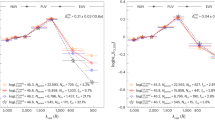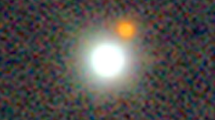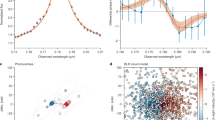Abstract
THE chief criticism1 of the gravitational interpretation of the red-shift in the spectra of quasars consists of three items: high electron density, differential gravitational red-shift and the small thickness of the line-emitting layer. Because there are, however, some phenomena suggesting that quasars are not at cosmological distances, it is interesting to try to construct models in which the difficulties imposed by gravitational red-shift are avoided. Let us therefore modify the model studied by Greenstein and Schmidt1 by assuming that quasars are relatively cool bodies having eruptive atmospheres, the eruptions rising radially from the surface and then falling back. The Sun, for example, would have such an envelope if its gravitational field were strong enough for an appreciable red-shift effect; owing to the high escape velocity, the plasma bursts associated with flares and the solar wind particles could not escape but would fall back forming such an atmosphere.
This is a preview of subscription content, access via your institution
Access options
Subscribe to this journal
Receive 51 print issues and online access
$199.00 per year
only $3.90 per issue
Buy this article
- Purchase on Springer Link
- Instant access to full article PDF
Prices may be subject to local taxes which are calculated during checkout
Similar content being viewed by others
References
Greenstein, J. L., and Schmidt, M., Astrophys. J., 140, 1 (1964).
Hämeen-Anttila, K. A., Ann. Acad. Scient. Fenn. A VI, 260 (1967).
Burbidge, G., and Burbidge, M., Quasi-stellar Objects, 98 (W. H. Freeman and Co., 1967).
Wampler, E. J., and Oke, J. B., Astrophys. J., 148, 695 (1967).
Oke, J. B., Astrophys. J., 141, 6 (1965).
Broten, N. W., Clarke, R. W., Legg, T. H., Locke, J. L., McLeish, C. W., Richards, R. S., Yen, J. L., Chisholm, R. M., and Galt, J. A., Nature, 216, 44 (1967).
Clark, B. G., Cohen, M. H., and Jauncey, D. L., Astrophys. J., 149, L151 (1967).
Friedman, H., and Byram, E. T., Science, 158, 257 (1967).
Author information
Authors and Affiliations
Rights and permissions
About this article
Cite this article
HÄMEEN-ANTTILA, K. Gravitational Red-shift and Quasi-stellar Objects. Nature 218, 1040–1041 (1968). https://doi.org/10.1038/2181040a0
Received:
Revised:
Issue Date:
DOI: https://doi.org/10.1038/2181040a0
This article is cited by
-
Bulletin GRG, No. 25: List of publications
General Relativity and Gravitation (1971)
Comments
By submitting a comment you agree to abide by our Terms and Community Guidelines. If you find something abusive or that does not comply with our terms or guidelines please flag it as inappropriate.



